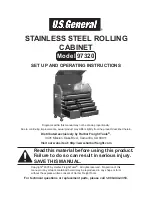
Table 28. Troubleshooting (continued)
None of the LEDs on an
individual component are
on.
Component might not be seated
correctly.
Ensure that the SAN384B has power and
component is firmly seated. If problem continues,
run the
sensorShow
command to determine
component status. If component is a CP blade or
port blade, enter the
slotShow
command to
determine the status.
Component might have failed.
Replace the component as necessary.
CP blades are failing over
frequently.
A third-party application has a
memory leak.
Check the application for memory leaks.
There is excessive serial port
activity.
Ensure that the serial port activity remains below
the specified amount.
CP blade is attached to an
Ethernet with high traffic loads.
Ensure that Ethernet traffic remains below
specified amount.
Chassis is overheated.
Enter the
tempShow
and
sensorShow
commands
to check the internal temperature. If components
are overheating, shut down port blades as
necessary to return the temperature to operating
range.
One or more port or router
blades have either shut
down or failed POST as
indicated by the error log.
Blades might be overheated.
Enter the
sensorShow
command to check the
internal temperature readings. If components are
overheating, shut down port blades as necessary to
return the temperature readings to the operating
ranges.
Blades might be faulty.
Enter the
slotShow
command to determine status.
For more information, enter the
diagDisablePost
command; then, the
slotPowerOff [slot number]
and
slotPowerOn [slot number]
command.
Resolve the source of the problem or replace the
blade as required.
Pins on the blade or the backplane
might be damaged.
Remove the blade from the chassis and inspect
pins on the blade and on the backplane inside the
slot. Do not reinstall if pins on either component
are visibly damaged, as this could damage pins on
other component. Replace the components as
required.
An individual component
is not operating as
expected.
Component may not have power
or may not be firmly seated.
Ensure component is receiving power (power LED
should be on) and component is firmly seated.
Pins on the component or the
backplane might be damaged.
Remove the component from the chassis and
inspect the pins on the component and inside the
chassis. Do not reinstall if pins on either
component are visibly damaged, as this could
damage pins on other component. Replace parts as
required.
The component might have failed.
Enter the
tempShow
and
sensorShow
commands
to determine component status. If component is a
CP blade or port blade, enter the
slotShow
command to determine the status. Replace the
component as necessary.
Appendix C. Diagnostics and troubleshooting
135
Summary of Contents for SAN384B
Page 2: ......
Page 10: ...viii SAN384B Installation Service and User Guide...
Page 12: ...x SAN384B Installation Service and User Guide...
Page 14: ...xii SAN384B Installation Service and User Guide...
Page 28: ...xxvi SAN384B Installation Service and User Guide...
Page 38: ...10 SAN384B Installation Service and User Guide...
Page 60: ...32 SAN384B Installation Service and User Guide...
Page 78: ...50 SAN384B Installation Service and User Guide...
Page 88: ...60 SAN384B Installation Service and User Guide...
Page 146: ...118 SAN384B Installation Service and User Guide...
Page 158: ...130 SAN384B Installation Service and User Guide...
Page 164: ...136 SAN384B Installation Service and User Guide...
Page 168: ...140 SAN384B Installation Service and User Guide...
Page 176: ...148 SAN384B Installation Service and User Guide...
Page 181: ......
Page 182: ...Part Number 45W8160 Printed in USA GC52 1333 02 1P P N 45W8160...
















































